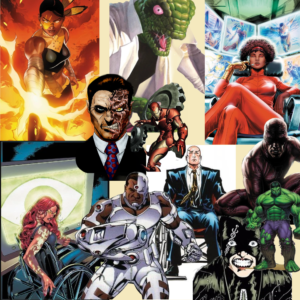Disability Representation in Comic Book Heroes and Villains: A Social Model Perspective
The representation of disability in comic books has been a complex and often problematic issue. Historically, disability has been portrayed through a medical model that focuses on individual impairments and frames disability as a personal tragedy or limitation. However, in recent years, a social model of disability has emerged that recognizes disability as a result of societal barriers and discrimination. This essay will explore the representation of disability in comic book heroes and villains through the lens of the social model of disability.
Ugly Laws and the Supremacy Culture
To understand the historical context of disability representation in comic books, it’s important to recognize the role of ugly laws and supremacy culture. Ugly laws were laws enacted in the late 19th and early 20th centuries that criminalized individuals with physical disabilities, particularly those who were disfigured or had visible impairments. These laws were a reflection of a broader societal belief in the supremacy of able-bodiedness and physical perfection.
Dominant Society Produces Disability
The belief in able-bodied supremacy has also produced disability, particularly in populations that have been devalued and under-resourced by dominant society. Disability has been used as a justification for excluding certain groups from social, economic, and political participation. When a society pathologizes and dehumanizes people with disabilities, it reinforces a narrative that positions them as villains or outsiders.
Villainization of Disability
In comic books, disabled characters have often been villainized and portrayed as evil or grotesque. This portrayal reinforces harmful stereotypes that associate disability with evil, punishment, or villainy. One example is Dr. Poison from Wonder Woman, who is depicted as a brilliant chemist with a facial disfigurement that motivates her evil deeds. Her physical difference is shown as the result of her own experiments, which further reinforces the idea that disability is a personal tragedy or punishment.
Similarly, the Red Skull from Captain America is a character with a disfigured face who is portrayed as the embodiment of evil. His facial difference is used as a visual marker of his villainy, reinforcing the idea that disability is a sign of moral corruption.
Heroes and Access Needs
In contrast to villainous portrayals of disability, there are also examples of disabled heroes in comic books. These characters challenge stereotypes and show that disability does not define one’s worth or potential. One example is Oracle, a character from the Batman universe who was once Batgirl but became paralyzed after being shot by the Joker. Rather than being portrayed as a victim or villain, Oracle is a skilled hacker and strategist who uses her intelligence and access to technology to fight crime.
Another example is Echo, a deaf Native American superhero who possesses the ability to mimic any physical movement she sees. Echo is portrayed as a powerful and capable hero who uses her disability as a strength rather than a weakness.
Disability Futures
To imagine a future that is truly inclusive and equitable, it’s important to recognize the diversity of disabled experiences and perspectives. Comic book representation is one way to challenge harmful stereotypes and expand our understanding of disability. As Alison Kafer writes, “To live in the future, we must be able to imagine ourselves there.” By recognizing and celebrating disabled heroes and challenging harmful portrayals of disability in comic books, we can create a more inclusive and equitable future for all.
Conclusion
In conclusion, the representation of disability in comic book heroes and villains reflects broader societal attitudes towards disability. The villainization of disability reinforces harmful stereotypes that position disabled individuals as outsiders or villains. However, there are also examples of disabled heroes in comic books that challenge these stereotypes and show that disability can be a source.

